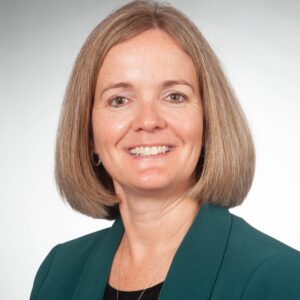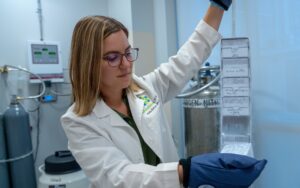Before surgeon Emily Penman, M.D., begins a mastectomy or lumpectomy, her lightly sedated patient receives a nerve block to control pain after surgery.
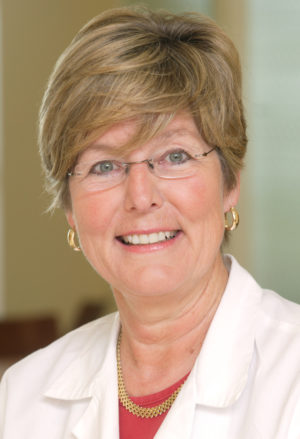
Its effectiveness, when combined with other anti-inflammatory medications, has lowered the need for opioids while reducing by 30 percent the proportion of patients who experience severe pain in the post-anesthesia care unit.
Christiana Care Health System is successfully reducing its use of opioids systemwide, including in post-surgical prescribing, its emergency departments and in primary care.
New evidence of its progress includes:
- A 40 percent reduction in the number of opioids prescribed after some OB-GYN and general surgery procedures.
- A reduction by almost 50 percent in the rate of opioid prescriptions among discharged emergency department patients.
- A 37 percent reduction in primary care patients on chronic opioid therapy in a pilot project.
There is plenty of progress to make. In 2012, Delaware was the nation’s No. 1 prescriber of high-dose opioid pain relievers and 17th in opioid prescriptions overall. By 2016, Delaware saw a death on average once a day from an opioid overdose.
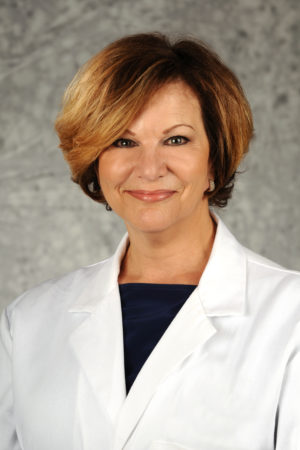
“We’ve embarked on a multifaceted strategy to educate providers about responsible prescribing practices, promote non-opioid alternatives to control pain and spread evidence-based guidelines around opioid prescription,” said Linda Lang, M.D., chair of Christiana Care’s Safe Opioid Stewardship Steering Committee and chair of the Department of Psychiatry.
The overall goals of Christiana Care’s efforts are to reduce chronic opioid use, combat addiction and ultimately reduce overdose deaths. Because primary care offices are the single largest source of opioid prescriptions, it is there that much of the progress can be made.
Opioids at the doctor’s office
Whether their pain is sudden or chronic, most patients first go to their primary care doctor for help.
Christiana Care is putting non-opioid alternatives front-and-center in patients’ electronic medical record, educating providers about alternatives to pain and identifying patients on long-term opioid at the highest risk, said Roger Kerzner, M.D., FACC, clinical director for specialty services at the Medical Group of Christiana Care.
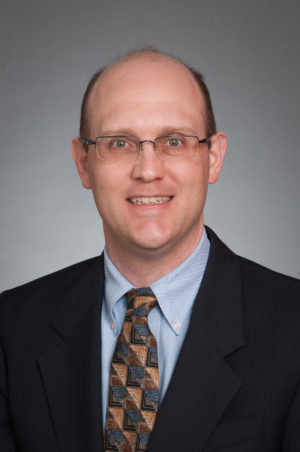
Data analysis is one tool to identify patients who are at higher risk of accidental death from chronic opioid use due to their other medications, health conditions and other factors, said Ed Ewen, M.D., director of clinical data and analytics and a primary care Many patients are first exposed to opioids after a surgical procedure, and too many of them eventually become dependent on Bthem.physician at Christiana Care.
“We can find those patients and focus on them with a concerted team effort to mitigate their risk,” Dr. Ewen said.
Another key focus, Dr. Kerzner said, is to try alternative approaches for patients who started using opioids in the past few months and whose use may become chronic.
There is some evidence that a team approach focusing on high-risk populations can pay off.
A pilot project at the Rocco A. Abessinio Family Wilmington Health Center at Wilmington Hospital resulted in a 37 percent reduction in the number of patients on chronic opioid therapy.
Delaware OPEN tackles acute pain
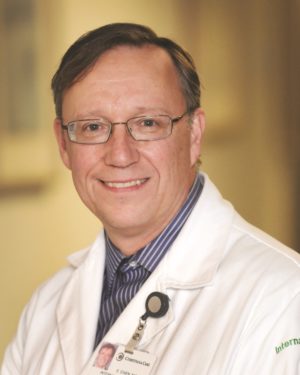
Many patients are first exposed to opioids after a surgical procedure, and too many of them eventually become dependent on them.
Building on the work by a grant-funded effort in Michigan called the Opioid Prescribing Engagement Network, or OPEN, Christiana Care developed a straightforward set of guidelines that recommend specific medications and quantities after 21 surgical procedures.
Led by anesthesiologist Matt Powell, M.D., Delaware OPEN intends to reduce the wide variation in the number and type of opioids prescribed after surgeries. Patients who are prescribed more opioids than they need sometimes hold on to them and use them later for ailments like pain, depression or trouble sleeping, he said.
Often, prescribing fewer opioids means accepting some level of pain after a procedure. Dr. Powell says doctors are now talking about pain in terms of function: Can the patient work, sleep and carry out other everyday tasks?
Though the guidelines are optional for prescribers, the early data showing a 40 percent reduction in opioids — which relates to 14 types of surgical procedures performed from July 2017 to July 2018 — shows many are taking the new advice.
On Aug. 15, Christiana Care hosted a team from Michigan who shared their results to a statewide audience that included other Delaware health systems.
ED cuts opioid prescriptions in half
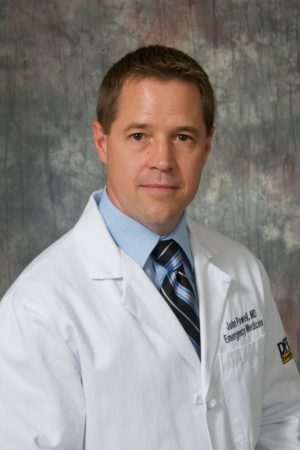
Christiana Care’s emergency departments, too, are engaged in finding alternatives to treat acute pain.
Christiana Care’s three emergency departments are successfully tackling the addiction crisis from both ends by helping those with a substance-use disorder access treatment and by prescribing opioids more appropriately.
Its success in cutting by nearly half the rate of opioid prescriptions among discharged patients, to 8 percent in May 2018, is thanks to a combination of several efforts, including the implementation of new opioid prescription guidelines developed by the Delaware chapter of the American College of Emergency Physicians, or ACEP.
“Our repeated education of Delaware ACEP guidelines, along with initiatives like Middletown’s Opioid Alternative Environment and the Suboxone pilot, has helped us treat pain in an appropriate manner without prescribing needlessly,” said John T. Powell, M.D., MHCDS, FACEP, chair of the Department of Emergency Medicine at Christiana Care.
By tapping Project Engage’s peer counselors to meet with patients, the emergency departments are identifying those struggling from withdrawal.
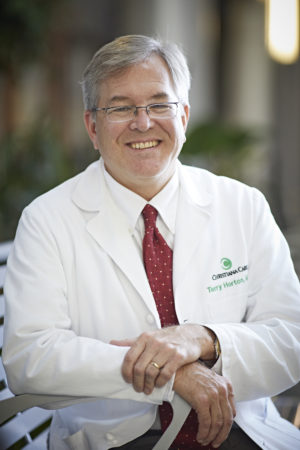
When appropriate, the emergency department is piloting a program to start these patients on Suboxone, a medication that provides immediate relief from the symptoms of withdrawal, and also connects them with an all-hours treatment center that offers medication-assisted therapy and counseling.
Meanwhile, the Middletown Emergency Department is developing alternatives to opioids in an effort called the Opioid Alternative Environment. That doesn’t mean opioids have no place there, but that other methods — including trigger point injections of anesthetic and, in some cases, IV acetaminophen — will be tried first.
Removing the fuel for addiction
Terry Horton, M.D., chief of Christiana Care’s Division of Addiction Medicine, likens the battle against opioid over-prescription and addiction to a raging forest fire.
Such a fire, he said, is most dangerous when it can tap into a ready fuel source, like downed trees and dry undergrowth. If you can remove the fodder, you can limit the risk of a major conflagration.
“Our efforts to prescribe opioids responsibly are reducing the fuel for that fire,” Dr. Horton said, “

